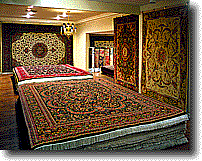Because of the desire of home owners to use more hard-flooring we are seeing a tremendous increase in the use of Oriental rugs throughout the home: dining-rooms, living-rooms, kitchens and even bathrooms.

Always know what you are buying: 100% wool? or silk/rayon added?
A new trend we have been seeing over the last several years is the addition of Silk and/or Rayon accent fibers woven into the face yarns. Rayon, also commonly know in the designer trade as “viscose” is problematic when cleaned. When these rugs are washed the main face fibers (wool) responds to cleaning very well, the rayon lays flat when water based detergents are applied and unfortunately will not “puff” back up when dried, creating a matted look-completely different from how it looked when new. We explain it to clients this way: When your pet (dog) is washed her fur matts down due to the water, but during drying her furs puffs back up and is fuller and brighter than before-now imagine your dog’s fur staying flat-her appearance would change dramatically-and not in a good way.
This is what happens when silk or rayon are used as accent fibers in specialty area rugs. Also, be aware that both silk and rayon (viscose) get weaker when wet, creating pulls throughout the rug.
Is there a solution?
- Know what you are purchasing. Ask the dealer or designer for exact specifications as to the fiber content.
- Clean more often. These accented rugs may have to be solvent a.k.a. “dry” cleaned. Dry cleaning is an acceptable method of cleaning but does not not remove the amount and various types of soiling that water based cleaning will.
- Do not place these specialty rugs in a high traffic area. Don’t let them get dirty.
- Maintenance: Vacuum gently, but often. Spot clean spills quickly, making sure you have both a water based spotting detergent that is safe for wool, silk & rayon and a solvent spotting solution. Remember to test for dye bleed and texture changes prior to applying spotters in a visible area.
Thanks for reading-I welcome your comments.
David Mavilio


